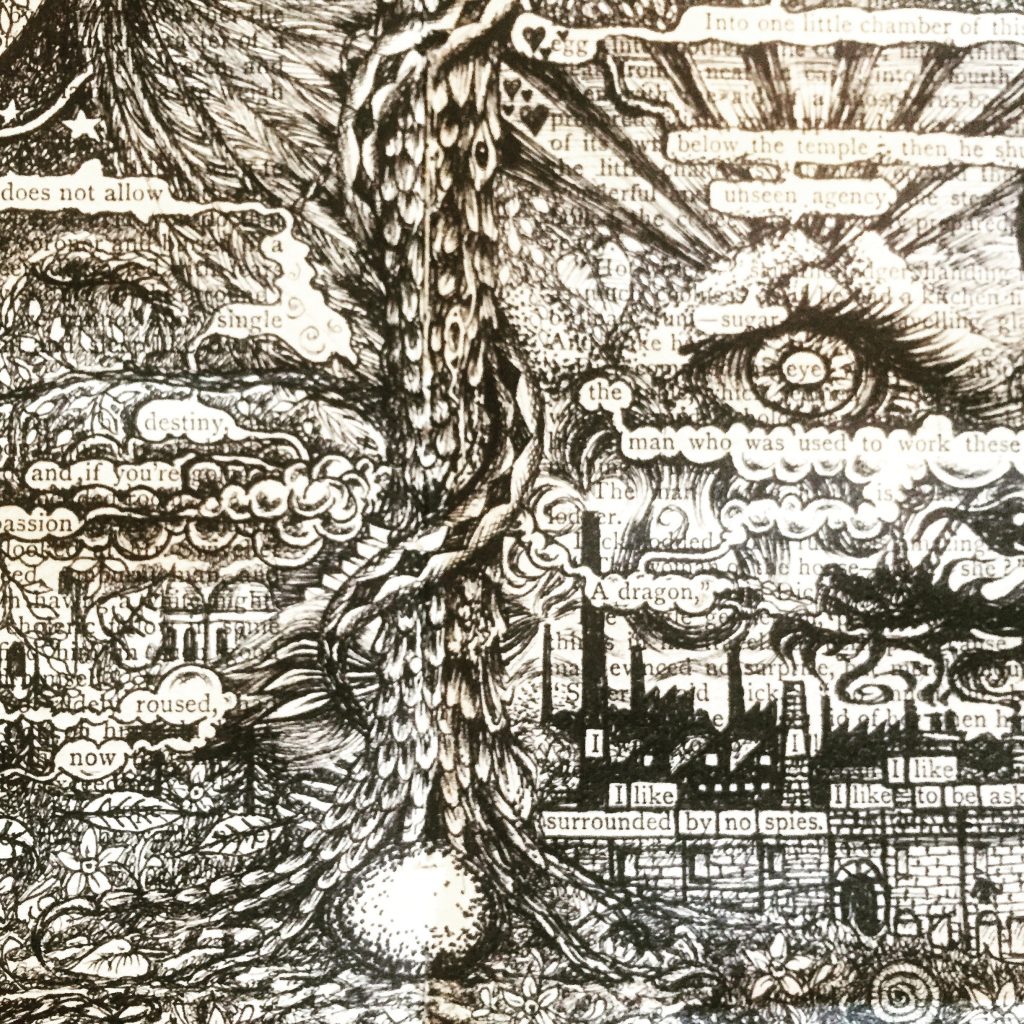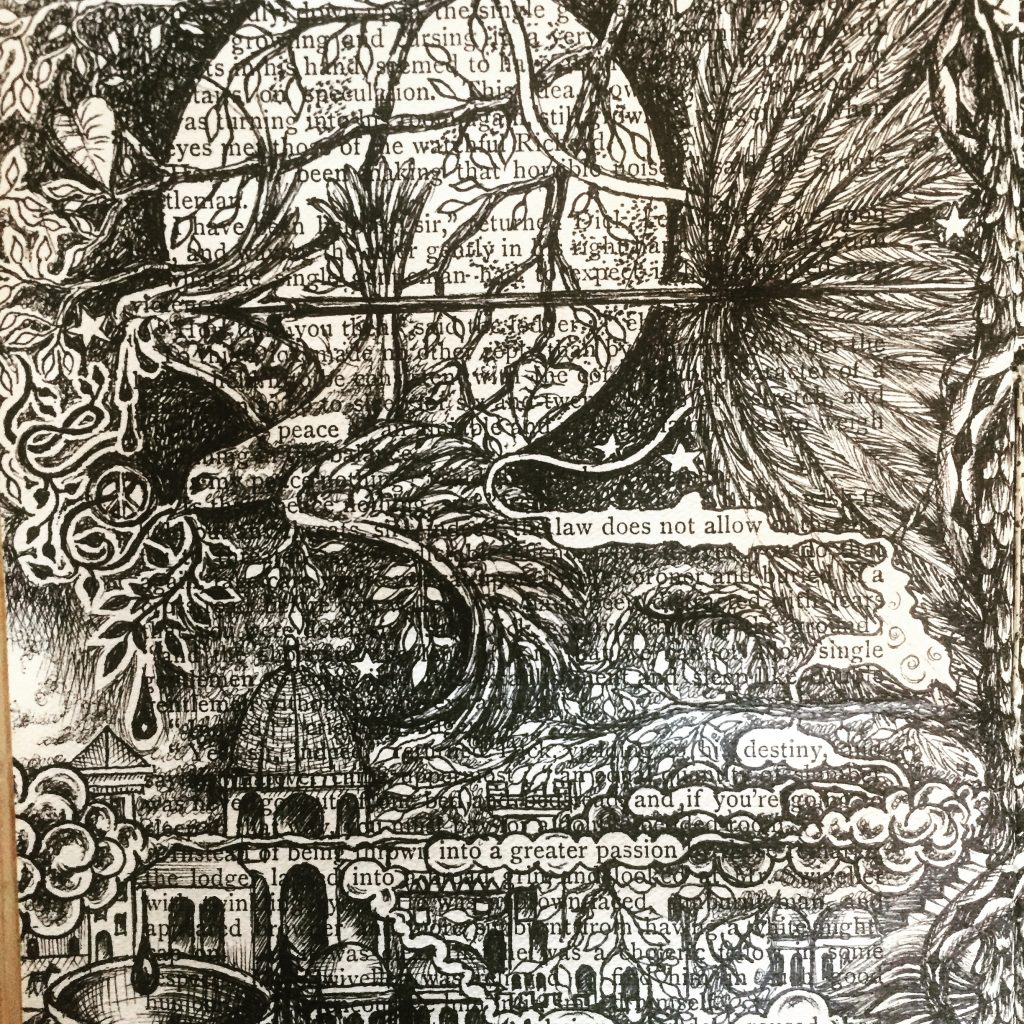Dickens Re-Focused: Hebden Bridge Artists Suggest New Ways to Interpret Classics
In this post, Catherine Quirk (@quirk_catherine) interviews Melinda Joy Chantler and Clare Lupino of Arcanum in Hebden Bridge about their collaborative Treated Books project. In their most recent work, they interpret Charles Dickens’s The Old Curiosity Shop (1840-1) by collaboratively drawing into the pages. As they work, they not only turn the physical book itself into a work of art, but also reveal connections between Dickens’s novel and modern society.
Thanks for agreeing to be interviewed for the Dickens Society Blog! To begin with, tell us a bit about yourselves, and about how you became collaborators.
Melinda Joy Chantler and Clare Lupino met 14 years ago when each of their children were in the womb.
Clare: “As we are both artists with similar beliefs, we hit it off immediately. We met up regularly as our babies grew to talk about Art, our work, and our dreams. It was always supportive and life-affirming”.
Melinda: “When the opportunity came up last year for us to join our creative forces together in a retail-gallery situation we didn’t hesitate. We established Arcanum in Hebden Bridge (a town already known for its enterprising creative spirit and independent retailers) with much support from our local community”.
Clare: “At Arcanum we showcase our individual work, sharing the opening hours and financial commitments. We have found a way to make it work. Like the women artists of the Renaissance, we are multi-disciplinary artists who refuse to allow our talents to be finite. Our ebb and flow process has led us to this most recent collaboration as well as continuing with our respective established creative practices”.
Melinda has practised as an exhibiting painter for several decades, having attended Leeds College of Art and Todmorden Art School where she studied Painting and Life Drawing and established her own unique style. Clare has a First Class (hons) in Contemporary Art and was an Art History lecturer for several years.
Independently, Melinda paints prolifically from her local studio, creating miniatures and large-scale statement pieces on canvas using traditional techniques employed by painters throughout Art History. She has a National and International client base. Melinda also creates Gilded Ram Skulls, found on the wild Yorkshire moors, as well as a range of Ceramics.
Trained as a Conceptual Artist, Clare also paints and draws and these skills are transposed into her bespoke Tattooing service. With clients coming from far and wide, Clare is known for her freehand tattooing skills, working with the contours of the body to translate her clients’ treasured ideas into unique tattoos. Clare doesn’t use transfers so each piece is a unique creation.
The attention to detail she gives to every client means she is often called upon to create hair-by-hair permanent tattooed eyebrows as part of her Living Portraits Service – second to none, she has worked on clients with Alopecia as well as those whose brows have thinned due to chemotherapy or general ageing.
Clare also showcases her jewellery at Arcanum, specialising in Vintage Transformations: she works with Art Deco and other vintage originals to create one-off bridal tiaras, exquisite neckpieces, wrist-cuffs and earrings. Many years ago, Clare trained at Royal Worcester to make petal-by-petal roses which she incorporates into her jewellery commissions alongside semi-precious stones and precious metals. Several celebrities own Clare Lupino jewellery, including Kate Moss and Honor Blackman.
Related to 1940’s film actress – and one of Hollywood’s first female directors – Ida Lupino, Clare likes to channel the glamour and intrigue of bygone eras. Each piece has its own hand-written story of its unique creation.
What kind of process do you use for your Treated Books Projects in particular? Does this differ from other work you’ve done (either separately or collaboratively)?
Melinda: “Since the opening of Arcanum a year ago, we have been working together on this series of Treated Books. This works not only because we both have similar styles of drawing and both have an academic level of skill, but also because as artists, we both have a reverence for spiritual approaches to Art”.
Clare: “Each piece begins with us deciding which page to select for our artistic treatment. We will discuss the content and reacquaint ourselves with the themes of each book so that the page we select will reflect the passion of the story and the concepts that the author was working with. We decide which text from the page we will leave exposed, linking words together to create our own personal sense. This provides a new perspective and forms the basis for the visual dialogue which begins between two artists. Much like the illuminated manuscripts in monastic communities, we are embellishing stories of great meaning for the people. It’s an honour”.
Melinda: “There is total trust and reverence between us as we work independently into the pages and each other’s drawing to create what people see as a seamless artwork, as though it were created by a single hand. This process intrigues visitors to Arcanum, who like to watch us work. The fact that we don’t feel the need to discuss a plan means that we trust entirely in the process whereby our communications are all visual. There is such a joyous feeling of surprise when we arrive at Arcanum to discover what the other has added to the composition the day before – and we find that the whole process confirms our beliefs that everything happens in divine order, which is in itself organic and enriched by our own perception of it. We are ‘morphing’ the concepts into today’s reality and in that sense it’s a metamorphosis of Art in an ever-deepening process”.
Clare: “The more you align yourself with the flow, the more it feels like you become a part of the great unfolding of the universe. I think all great artists, authors, musicians and dancers know this. As artists we know that we are channelling something – we feel it’s a divine energy. We are aware that we are ‘plugging into’ a visual database via our imaginations – just as authors like Dickens did when they created unfolding images in the minds of their readers. We simply allow our minds to connect to that and flow with it. We have no need to ‘prove’ our findings, like so many scientists. It’s an artist’s role to manifest the unseen and it’s a privilege to share our visions. In that sense we are lifting the veils of perception, revealing the deepest layers and showing people new glimpses into already great works”.
Historically, both artists have incorporated text into their work – Melinda has used a combination of photo-montage and text from spiritual books in her paintings, and Clare completed a Treated Book over 30 years ago when she painted and collaged into the whole of Lewis Carrol’s Alice in Wonderland – a work that took two years to complete.
What drew you to The Old Curiosity Shop? Could you walk us through your work, and how the images, exposed text, and other elements reflect your interpretation of the novel?
Melinda : “Amongst other significant works, we chose The Old Curiosity Shop because it symbolises Arcanum for us: it’s full of curiosities and marvels that we have created”.
The visual journey of this double page from The Old Curiosity Shop began when Melinda drew the dragon. Clare then “saw” it as black smoke coming from some chimneys and began to draw the row of Victorian terraces and backdrop of mill stacks, referencing the local architecture of Hebden Bridge. As a Northern mill town, Hebden Bridge was prolific during the Industrial Revolution – and it has a rich set of individual histories contemporary with those Dickens characterised. Indeed, he visited the Industrial North and was actually friends with one of Clare’s relatives on the Lupino side.
The selected text refers to the “unseen agencies” who gained so selfishly from the spoils of slave labour as part of the infrastructure of power on which Victorian Britain was established. A “banana boat” can be seen steaming across the ocean as part of the Slave Triangle – a portent of things to come. The rooftops of the crammed, pave-line terraced streets have become the ocean, as the mill workers drown in a less obvious form of enslavement. At a time when the essence of “refinement” in high society was represented by white cubes of sugar taken with tea (both products of the dominance of the British Empire), we have enhanced the word “sugar” within a sugar mountain.
In terms of today’s Britain, it is interesting that in 2018, when the majority of consumers have a mild to moderate sugar addiction, the government are proposing a Sugar Tax with predictions as to the guaranteed revenue relating to average consumption.
Dickens was writing at a time when London had the status it did as a result of the Slave Trade and yet the poor aspired to dream about the choices of the rich (“one lump or two?”). The order prevails in real terms beyond the legacy of Dickens’ commentaries.
There are references also to the emblems and aggrandisement of the Christian church which had actually demoted the peace that Jesus came to preach (even naming one of the slave ships “Jesus”). But although the arrow pierces the dove of Peace, its blood is collecting in the Holy Grail, a symbol of the Sacred Feminine and a reference to the importance of women in human society. An apple, fallen from the Tree of Knowledge, connects us to our desire for self awareness via experience of Nature, even in times when our collective spirit is being “de-natured” and – as referenced by the scorpion – we will be stung by our own knowledge.
Clare: “In the text we have selected we refer to Destiny in that every choice we make can create a new destiny”.
Melinda: “Dickens shows us a set of circumstances and his characters respond to them in a myriad of ways, which determines the shaping of their destinies. Self-mastery is key”.
Do you have a narrative or interpretation in mind before you begin, or does the narrative form as you work? In either case – does it stem primarily from the images? From those words and phrases left exposed? From the interaction between the two?
Clare: “The narrative just unfolded day by day. We revel in the synchronicity that abounds in this miraculous world. Such meaning! We just allow it to flow through us onto the pages we create and connect with the energy of the author to that expansive database that is the imagination. There is such potency in Dickens’ placement of words and we are encouraging readers to refocus in unexpected ways by visually articulating the layered heights and depths”.
Melinda and Clare are working on several Treated Books – soon to be showcased via Arcanum and other exhibitions – each one deeply meaningful to them both.
You can view a selection of their individual painting, jewellery, and tattoo work, as well as a selection of their Treated Books, online and on social media – follow on Instagram, on Twitter (@lupinotattoos and @lupinojewellery), or on Facebook (and also here).
Prints are available on request at £80 unframed, or £130 framed.
Clare and Melinda are looking for galleries and exclusive retail outlets who would be interested in offering them an exhibition for their Treated Books or stocking their work. They will consider working into specific books.
Contact Melinda Joy Chantler / Clare Lupino
07779749909 / 07757655061



